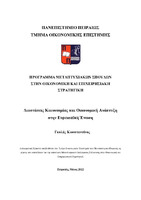Διαστάσεις καινοτομίας και οικονομική ανάπτυξη στην Ευρωπαϊκή Ένωση
Innovation dimensions and economic growth in the European Union

Προβολή/
Λέξεις κλειδιά
Πλαίσιο καινοτομίας ; Επενδύσεις καινοτομίας ; Δραστηριότητες καινοτομίας ; Επιπτώσεις καινοτομίας ; Έρευνα και ανάπτυξη ; Διάχυση γνώσης ; Panel dataΠερίληψη
Η Ευρωπαϊκή Ένωση (ΕΕ) αναγνωρίζει ότι μια οικονομία πρέπει να λειτουργεί προς όφελος των πολιτών και του πλανήτη, με ανησυχίες για το κλίμα, το περιβάλλον και την τεχνολογική πρόοδο. Η Ευρωπαϊκή Πράσινη Συμφωνία είναι η νέα αναπτυξιακή στρατηγική της ΕΕ. Θέτει τη βιωσιμότητα και την ευημερία των πολιτών στο επίκεντρο της δράσης της, συνδυάζοντάς την με τέσσερις (4) συμπληρωματικές παραμέτρους: Περιβάλλον, Παραγωγικότητα, Σταθερότητα, Δικαιοσύνη.
Στο επίκεντρο αυτής της προσέγγισης υπάρχει μια βιομηχανική στρατηγική με ισχυρά θεμέλια στην ενιαία αγορά που θα δίνει τη δυνατότητα στις ευρωπαϊκές επιχειρήσεις να καινοτομούν και να αναπτύσσουν νέες τεχνολογίες. Η πορεία προς ένα βιώσιμο οικονομικό μοντέλο, χάρη στις ψηφιακές και καθαρές τεχνολογίες, μπορεί να καταστήσει την Ευρώπη πρωτοπόρο του μετασχηματισμού. Η ΕΕ εκτιμά ότι η μελλοντική αύξηση των εσόδων και της απασχόλησης στην Ευρώπη θα εξαρτηθεί σε μεγάλο βαθμό από την αύξηση της παραγωγικότητας και της καινοτομίας. Η επίτευξη υψηλότερης παραγωγικότητας απαιτεί συστηματική και μακρόπνοη στρατηγική για την έρευνα και την καινοτομία. Επιπλέον, ο χρηματοπιστωτικός τομέας στην Ευρώπη πρέπει να στηρίξει περισσότερο την καινοτομία και τις επενδύσεις στην οικονομία, καθώς η αύξηση της παραγωγικότητας και της καινοτομίας δεν μπορεί να επιτευχθεί χωρίς εκτεταμένες επενδύσεις στην εκπαίδευση και την ανάπτυξη δεξιοτήτων.
Στο πλαίσιο όλων αυτών των στρατηγικών στόχων και προτεραιοτήτων οικονομικής πολιτικής που εκτέθηκαν ανωτέρω, η Ευρωπαϊκή Ένωση χρησιμοποιεί τον ετήσιο Ευρωπαϊκό Πίνακα Αποτελεσμάτων για την Καινοτομία (European Innovation Scoreboard, EIS) προκειμένου να αξιολογήσει συγκριτικά τις επιδόσεις Έρευνας και Καινοτομίας των κρατών μελών της Ένωσης, καθώς και τα σχετικά πλεονεκτήματα και τις αδυναμίες των συστημάτων έρευνας και καινοτομίας τους. Η έκθεση EIS 2021 είναι η πρώτη έκδοση που δημοσιεύεται χρησιμοποιώντας το αναθεωρημένο πλαίσιο μέτρησης, συμπεριλαμβανομένων νέων δεικτών που αποτυπώνουν την ψηφιοποίηση και τη βιώσιμη καινοτομία. Το νέο πλαίσιο μέτρησης του EIS διακρίνει μεταξύ τεσσάρων (4) κύριων τύπων δραστηριοτήτων, αποτυπώνοντας δώδεκα (12) διαστάσεις καινοτομίας και συνολικά τριάντα δύο (32) διαφορετικούς δείκτες.
Και το σχετικό ερευνητικό ζήτημα διατυπώνεται ως ποιες από τις διαστάσεις του αναθεωρημένου Πίνακα Επιδόσεων Καινοτομίας επηρεάζουν, θετικά ή αρνητικά, την οικονομική ευημερία των πολιτών των κρατών της Ευρωπαϊκής Ένωσης. Τα αποτελέσματα της ανάλυσης, τα οποία βασίζονται σε 28 Ευρωπαϊκές χώρες για την περίοδο της τελευταίας δεκαετίας μας παρέχουν ενδείξεις για τη θετική και στατιστικά σημαντική επίδραση στο Κατά Κεφαλήν Ακαθάριστο Εγχώριο Προϊόν που ασκούν οι διαστάσεις σχετικές με την διάχυση της γνώσης & τα ελκυστικά ερευνητικά συστήματα, την διάθεση επιχειρηματικών κεφαλαίων, τις δεξιότητες σε Τεχνολογίες Πληροφοριών και Επικοινωνιών, τις καινοτομίες προϊόντων, τις υπηρεσίες έντασης γνώσης και την περιβαλλοντική βιωσιμότητα.


